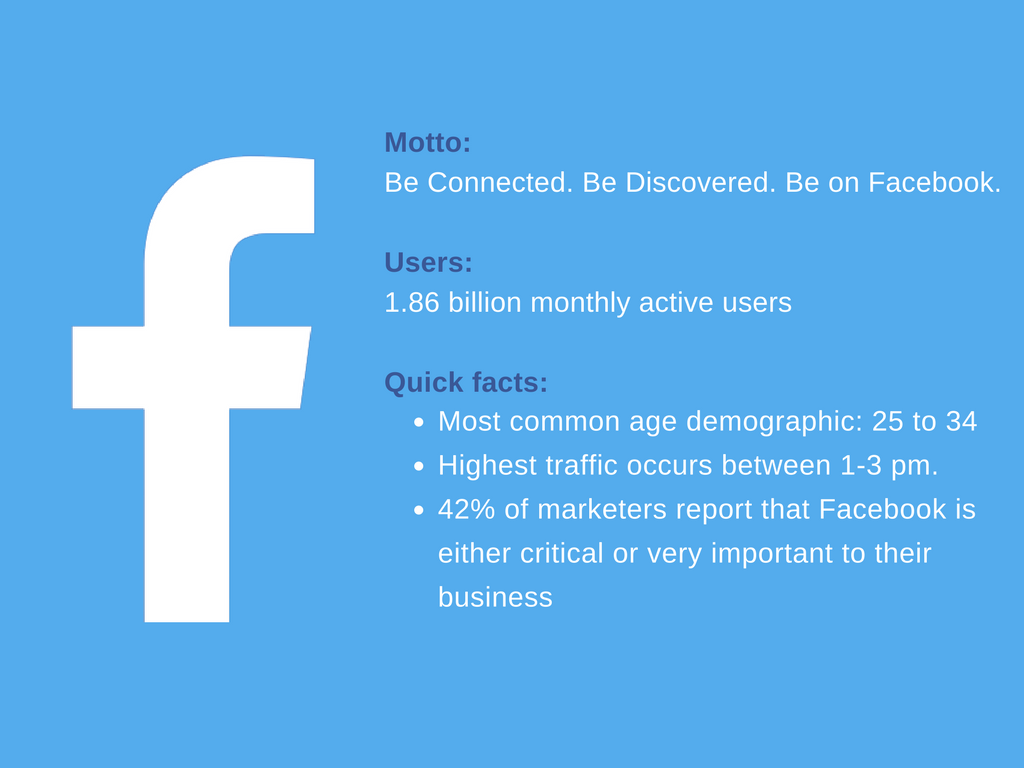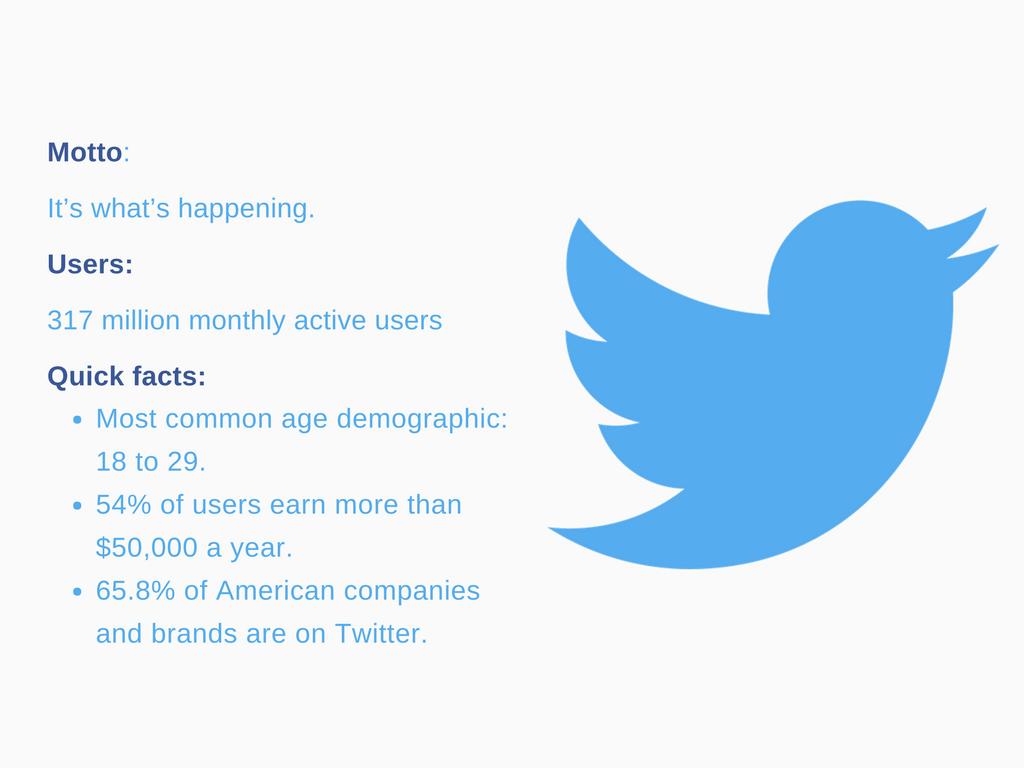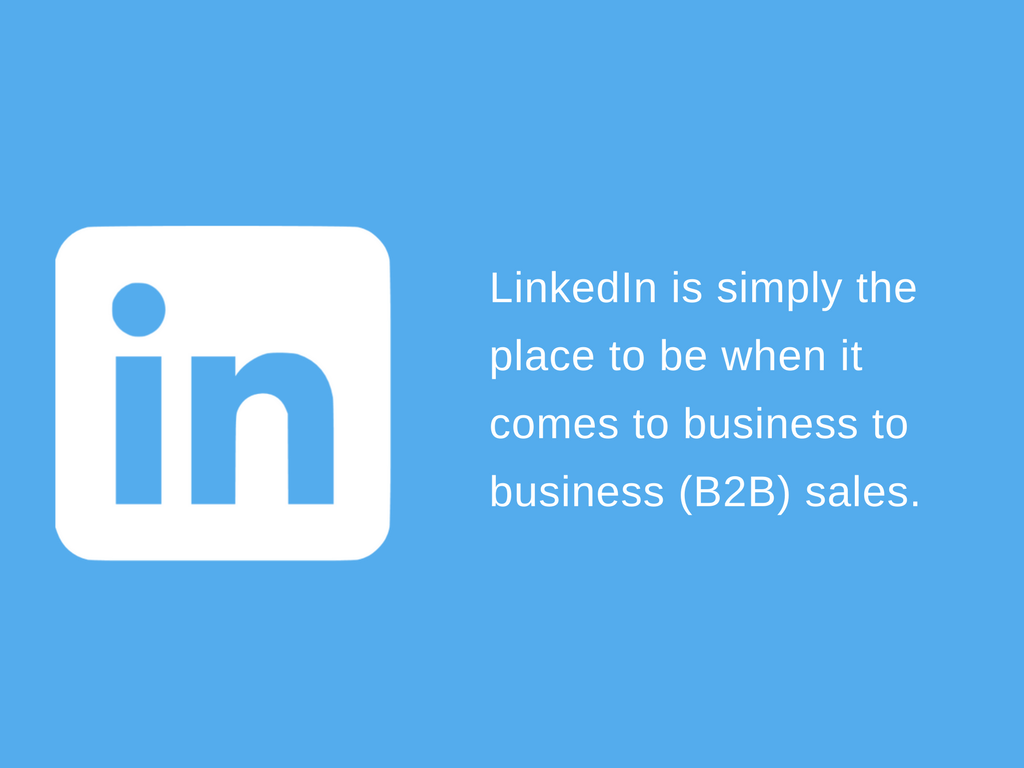Social networking: what to talk about on Facebook, Twitter, and LinkedIn

When it comes to social networking, there are three main platforms that reign supreme: Facebook, Twitter, and LinkedIn.
Regardless of who your audience is, your business model, or your marketing strategy, one factor remains constant: social networking is a must.
To build your influence as an expert, connect with your audience, and find speaking opportunities, social networking is an important part of marketing and growing your speaking business.
And, while you may already have your accounts set up, do you know the difference between the three sites and how to use them effectively?
Let’s take an in-depth look at Facebook, Twitter, and LinkedIn to examine the difference in audience and what to post on each platform.

Motto: Be Connected. Be Discovered. Be on Facebook.
Users: 1.86 billion active users monthly
Quick facts:
-
Most common age demographic: 29.7% of users are age 25 to 34.
-
Highest traffic occurs mid-week between 1 and 3 pm.
-
42% of marketers report that Facebook is either critical or very important to their business.
Why should you be using Facebook to grow your speaking business?
Facebook is, hands down, the biggest and most popular social networking site in the world.
It is both important and necessary to promote your speaking business on Facebook. Share your videos, talks, and upcoming events within your network simply because it has the largest pool of potential event organizers and audience members.
Who is the audience?
Think of Facebook as everyone and anyone.
While Twitter’s user base has a tendency to be younger and higher-educated, and LinkedIn’s to be more professionally oriented, Facebook consists of a variety of users across all of the demographics.
What we can say, however, is that it is a great place to talk about your business and engage with your audience. Each Facebook user is connected to an average of 80 pages, groups, or events. This means that while they may be primarily using Facebook to connect with friends and family, it is also a goldmine for business networking.

What should you post?
Facebook is a great place to promote your speaking business.
Speak as you do you when you are up on stage. People like to feel that it is really you behind the posts, and if they have the feeling that everything is automated or that someone else is creating your posts for you, they may lose interest. Make sure you keep that Facebook page active and interesting. Engage with your audience as much as possible.
Share photos, updates, and recent presentations with your audience. Fans of your talks will come to your Facebook page to get updated on your recent talks and further insights you have related to your topics and expertise.
Build your position as an expert on your topic by sharing valuable content, such as relevant articles, topic-specific videos or studies, and information on the latest trends in your industry. It doesn’t have to be 100% about your presentations, but keep your content varied and related to your topics.
While it’s important to stay true to yourself and be transparent, use discretion when sharing what you’re doing, thinking, or feeling.
Remember that you are using this to build your business. Perhaps keep your brunch photos or travel gripes on your personal Facebook account, or if you are only going to have one account, adjust your privacy settings appropriately.

Top tips for posting on Facebook:
-
Posts with the highest interactions are shorter: ideally between 100 and 119 characters.
-
Posts that ask questions tend to improve interaction by 10 - 20%.
-
Photos get 53% more likes, 104% more comments, and 84% more click-throughs on links than posts which are text-only.
-
Engagement rates on Thursday and Friday are 18% higher.

Motto: It’s what’s happening.
Users: 317 million monthly active users
Quick facts:
-
Most common age demographic: 37% of Twitter users are between ages of 18 and 29.
-
54% of Twitter users earn more than $50,000 a year.
-
65.8% of American companies and brands are on Twitter.
Should you be using Twitter to grow your speaking business?
Twitter is a very active and fast moving place.
While the average Twitter user has 208 followers and around 300 Tweets, they spend a whopping 170 minutes on Twitter each day. At least 29% of Twitter users are active several times a day. This means they are mostly reading and scrolling through other people’s posts.
Twitter is full of potential when it comes to growing your speaking business.
But, to be upfront, Twitter is better for building a loyal audience and increasing your influence than it is for generating leads and new speaking opportunities.
85% of Twitter users “feel more connected” to a business (or speaker) after they follow them on Twitter, which is ideal for building your influence but less ideal for generating click-throughs.
Sharing great content on Twitter can elicit a handful of new followers and retweets, but more often than not, the majority of your audience will have already found you through somewhere else, like from attending a conference you were in or from an article they read.
Who is the audience?
Twitter has a smart audience. Celebrities, politicians, writers, industry specialists, and speakers alike are on Twitter. Believe it or not, 83% of 193 UN member countries have a Twitter presence.
You can connect with strangers and friends with equal ease. If you’re about to go speak or attend a conference, search Twitter for the associated hashtag to discover who else is going and make connections before you even get there.
You can connect with colleagues, event organizers, other speakers, and your audience in one fell swoop on this platform.

What should you post?
The most important thing to remember is to be enticing and post often.
Twitter users are going to go on Twitter for a short time a few times a day, picking only one or two articles out of the dozens or possibly hundreds of articles that are scrolled through.
Make sure your posts stand out by offering content (advice or statistics) up-front or including key hashtags to let the reader know what is in store for them if they click your link.
Using hashtags makes your Tweet more searchable, which is perfect for reaching audiences outside of your current followers.
Drive traffic to your website or to places where readers can find more of your content like your blog or LinkedIn Pulse page. Share easy-to-digest advice, trends, or statistics about your speaking topic or industry.
Retweet someone’s post if it's informative, engaging, or relevant to your speaking topics and business.

Top tips for posting:
-
Tweets get more traction when they are shorter: ideally between 100 and 130 characters.
-
Tweets with images received 18% more clicks, 89% more favorites, and 150% more retweets. Images perform better than videos.
-
Tweets with links get retweeted 86% more often.
-
Use relevant hashtags.

Motto: Relationships Matter.
Users: 106 million monthly active users
Quick facts:
-
Most common age demographic: 61% of LinkedIn users are 30 to 64 years old
-
44% of LinkedIn users earn more than $75,000 a year.
-
94% of B2B marketers use LinkedIn to distribute content and 57% of companies have a LinkedIn Company Page.
Should you be using LinkedIn to grow your speaking business?
With more than 270 million users, and almost half of those visiting at least once a month, LinkedIn has the numbers to compete with Twitter and Facebook. But, numbers aside, LinkedIn is simply the place to be when it comes to business to business (B2B) sales: meaning if you want to find event organizers in your industry, this is where you need to be.
Who is the audience?
LinkedIn is a pool of professionals and is business focused. Whereas anyone can connect on Twitter, LinkedIn is for the people you know and trust. Your credibility is not increased solely by numbers but by the quality of your connections.
The LinkedIn audience is more focused on B2B marketing than on business to customer (B2C) marketing. It is where you can position yourself as an expert and share that expertise to attract event organizers and industry experts, rather than build a large audience of followers. .

Share your expertise.
60% of LinkedIn users are interested in industry-specific insights, followed closely by the 53% of users who are interested in updates such as your events, videos, and latest news.
When posting to LinkedIn Pulse, make sure the content is relevant, helpful, and actionable as opposed to promotional.
It’s important to note that LinkedIn sends nearly four times more people to your website/blog than Twitter and Facebook. Twitter and Facebook are great for sharing social stories, links to your articles, and visual media, but LinkedIn is the number one source when it comes to traffic referrals.
A key way to build your network and to share your expertise is by joining groups and exchanging ideas within your industry and with other speakers (Top tip: join the SpeakerHub network ‘Need a Speaker/Be a Speaker’).

Top tips for posting on LinkedIn and LinkedIn Pulse:
-
According to LinkedIn research, people who share articles or content once a week are nearly 10x more likely to be contacted for new opportunities than people who don’t share anything.
-
Keep your content varied: links get 200% more engagement, images get a 98% higher comment rate, and videos get a 75% higher share rate.
-
Stay neutral. Neutral language posts tend to see more comments and post views than posts with either positive or negative sentiments.
-
60% of the top performing titles on LinkedIn Pulse posts use the words “you/your”, “how to”, “lists”, or “hacks” in the title.
-
Titles which are 40 to 49 characters in length receive the greatest number of post views overall.
Create an account on SpeakerHub, the network created for speakers and event organizers. Setting up a speaker profile on SpeakerHub is free and easy. Find out more here.








